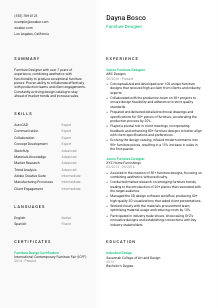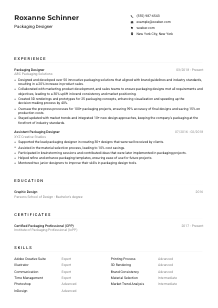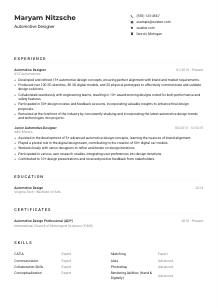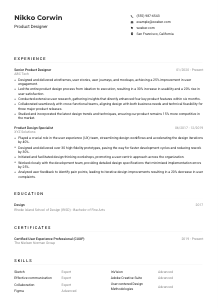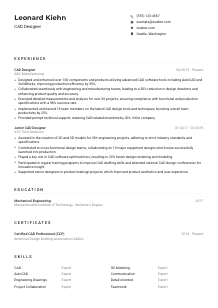Furniture Designer Resume Example
Shaping beautiful narratives with wood, but your resume feels a bit grainy? Explore this Furniture Designer resume example, honed with Wozber free resume builder. Learn how to flawlessly dovetail your design talents with job specifications, carving out a career path as remarkable as your creations!
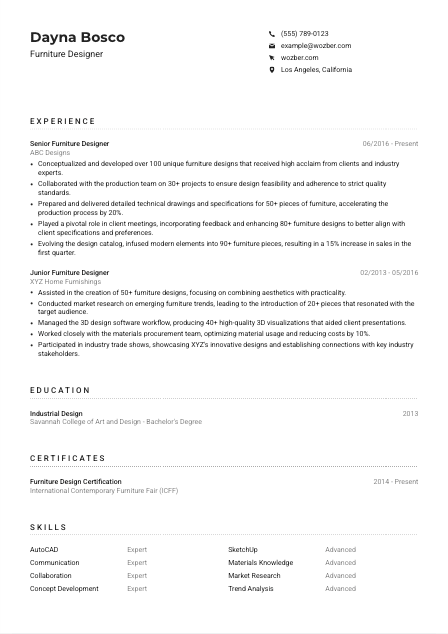
How to write a Furniture Designer Resume?
Hello, aspiring Furniture Designer, poised to redefine living spaces with your innovative designs! In the intricate world of furniture design, where aesthetics meets ergonomics, your resume is the blueprint of your career journey. With the competitiveness in the field, having an ATS-compliant resume, that speaks both to the human eye and the ATS algorithms, is paramount. Leveraging the free resume builder, Wozber, we will guide you through crafting a resume with an ATS-friendly resume template and unravel the art of ATS optimization with our ATS resume scanner, ensuring your resume is a masterpiece ready for the job market.
Personal Details
Before diving into the design process, let's set up your workspace with the foundational element of your resume - the Personal Details. Think of it as your quest to create the perfect chair; it should be inviting and tell a story at a glance. Sculpt your introduction with precision, aligning it with the Furniture Designer position you're targeting.
1. Brand Yourself With Your Name
Your name is the logo of your personal brand. Ensure it is prominently displayed, bold and clear, just like a designer's signature on their creation. Choosing a sans-serif font can add a modern touch, setting the tone for your resume.
2. Tailor to The Role
"Furniture Designer" isn't just a title; it denotes your identity in the industry. Place it beneath your name, resonating with the role from the get-go. It's like selecting the right material for your furniture piece - it shows you know what you're crafting.
3. Essential Contact Elements
Your contact information is the invitation for collaboration. Highlight your professional email and phone number, ensuring they are error-free. Think of it as the fine print on a designer's label, necessary for further engagement.
4. Location Precision
"Los Angeles, California" not only matches the job's geographical requirement; it also serves as a confirmation that you're in the heart of the design world, ready to engage. Including this, subtly assures there's no room for relocation delays.
5. The Professional Online Portfolio
In the realm of design, showing surpasses telling. A link to your professional website or portfolio can be your showroom, enticing hiring managers to explore your past projects. Just as a furniture showroom allows one to visualize pieces in space, your online portfolio demonstrates your expertise.
Takeaway
Consider your Personal Details as the introductory sketch in your portfolio; it sets the tone for what's to follow. Craft it with care, ensuring every line and contour aligns with what hiring managers seek in a Furniture Designer. Just as every piece tells a story in your portfolio, so does the information about you.





Experience
The heart of any resume, especially for a Furniture Designer, is the showcase of experience. This section is your exhibition space, where each project you've contributed to tells a story of creativity, technical prowess, and collaborative spirit. Let's lay out how to curate this gallery of your professional journey.
- Conceptualized and developed over 100 unique furniture designs that received high acclaim from clients and industry experts.
- Collaborated with the production team on 30+ projects to ensure design feasibility and adherence to strict quality standards.
- Prepared and delivered detailed technical drawings and specifications for 50+ pieces of furniture, accelerating the production process by 20%.
- Played a pivotal role in client meetings, incorporating feedback and enhancing 80+ furniture designs to better align with client specifications and preferences.
- Evolving the design catalog, infused modern elements into 90+ furniture pieces, resulting in a 15% increase in sales in the first quarter.
- Assisted in the creation of 50+ furniture designs, focusing on combining aesthetics with practicality.
- Conducted market research on emerging furniture trends, leading to the introduction of 20+ pieces that resonated with the target audience.
- Managed the 3D design software workflow, producing 40+ high‑quality 3D visualizations that aided client presentations.
- Worked closely with the materials procurement team, optimizing material usage and reducing costs by 10%.
- Participated in industry trade shows, showcasing XYZ's innovative designs and establishing connections with key industry stakeholders.
1. Analyze the Job Blueprint
Start by dissecting the job description. Highlighting phrases like "conceptualize and develop unique furniture designs" or "collaborate with the production team" underlines what your prospective employer values.
2. Exhibit Your Masterpieces
Arrange your roles and companies as you would pieces in a showroom - most impactful design at the forefront. For example, "Senior Furniture Designer at ABC Designs" immediately draws attention, much like a statement piece in the center of a room.
3. Narrative of Accomplishments
Detail your achievements in a manner that intertwines with the job requirements, painting a vivid picture of your capabilities. Statements like "Conceptualized and developed over 100 unique furniture designs" spotlight your creative genius, while "Collaborated with the production team on 30+ projects" showcases your teamwork acumen.
4. Quantify Your Craft
Numbers are the universal language of impact. Quantifying your achievements, maybe how a particular design boosted sales by 15%, helps paint a clearer picture of your value. It's akin to specifying the weight capacity of a chair – it clarifies its strength and utility.
5. Relevant Artistry Only
Maintain focus on experiences that mirror the skills and requirements listed in the job description. Much like choosing which sketches to develop into full designs, select the experiences that best reflect your fit for the role, ensuring not to clutter your resume with unrelated accomplishments.
Takeaway
Envision your experience section as a curated collection of your finest works, each piece selected for its relevance and impact. Tailor it thoughtfully, keeping the hiring manager's perspective in mind, and your resume will stand as a testament to your craftsmanship and vision as a Furniture Designer.
Education
In furniture design, the foundation of your knowledge is as critical as the structural integrity of the pieces you create. The Education section of your resume must reflect the core materials of your expertise, honed through years of study. Let's construct this section with the precision of a skilled artisan.
1. Identify the Core Material
Ground your education section in the job's requirements. In this instance, a "Bachelor's degree in Industrial Design, Furniture Design, or a related field" isn't just a specification; it's the hardwood of your resume, essential and robust.
2. The Blueprint Layout
Your educational qualifications should be laid out clearly. Think of it as articulating the dimensions of a piece; the degree, the institution, and the years of study should align seamlessly, offering a quick, understandable glance into your educational journey.
3. Tailoring Degree Details
Matching your degree to the job criteria is a meticulous task, akin to selecting the right wood grain for a project. If you hold a "Bachelor's Degree in Industrial Design," it perfectly aligns, serving as a centerpiece in this section.
4. Highlight Relevant Techniques
Although not always necessary, mentioning significant courses or projects can be like highlighting a particularly innovative joint technique in a piece. It showcases your attention to detail and commitment to the craft.
5. Showcasing Your Craftsmanship
For more junior roles or when shifting within the design field, emphasizing participation in design clubs, relevant projects, or honors can bolster your profile, much like the fine finish on a well-crafted chair highlights its quality.
Takeaway
Frame your educational background as you would a cornerstone of your design philosophy. It's a reflection of the foundational knowledge and the refined skills you bring to the drafting table. Let your education section communicate the depth of your expertise and your passion for continuous learning.
Certificates
In the furniture design world, certifications are like the accolades of craftsmanship - they signify mastery, attention to detail, and a dedication to staying ahead of the curve. Certifications can be the embellishments that distinguish you in a sea of designers, demonstrating your commitment to excellence.
1. Relevant Decorations
While the job description for our Furniture Designer role didn't specify required certificates, showcasing relevant achievements, such as a "Furniture Design Certification" from a recognized body, can add a layer of prestige and proof of expertise to your resume.
2. Curate with Care
It's about quality, not quantity. Highlight certifications that directly align with the job's demands or the furniture design industry, presenting them as marks of your commitment to the craft and professional growth.
3. Date and Detail
Including the acquisition date of certifications is akin to noting the period of a piece's design; it speaks to the relevance and currency of your skill set. If it's a recent certification, it underscores your active engagement in your professional development.
4. Continuous Learning
The design field evolves, and so should you. Regularly seeking new certifications, especially those that align with industry trends or technological advancements, showcases your adaptability and forward-thinking approach, vital traits for any designer.
Takeaway
Think of your certifications as the fine polish on your resume, enhancing its attractiveness and reflecting your dedication to excellence. They add depth to your professional portrait, signaling to hiring managers that you're a Furniture Designer of distinction.
Skills
In the toolkit of a Furniture Designer, skills are the hand tools and software critical for bringing visions to life. From drafting tables to design software, your skills section must detail your range of abilities, finely tuned through projects and practice. Let's meticulously assemble this crucial part of your resume.
1. The Job's Blueprint
Begin with a deep dive into the job description, identifying stated and implied skill requirements. Skills like "proficiency in 2D/3D design software such as AutoCAD and SketchUp" and a "strong understanding of materials" are your guideposts.
2. Showcase Your Toolkit
Present the skills that directly match the job description, ensuring a blend of technical and soft skills. This balanced display, much like a well-organized tool rack, allows hiring managers to quickly gauge your capability.
3. Organized and Accessible
Like a neatly arranged workspace, your skills section should be clear and concise. Avoid overcrowding with every skill you possess; instead, focus on those most relevant, ensuring they are easily spotted and appreciated by hiring managers.
Takeaway
Equip your skills section with the precision of a master craftsperson, selecting each skill for its relevance and impact. This careful curation ensures your resume mirrors the balance between aesthetic sensibility and technical expertise, casting you as the ideal Furniture Designer for the role.
Languages
For a Furniture Designer, the ability to communicate concepts and collaborate across cultures can enhance opportunities, especially in an industry that values innovation and diversity. Your language skills can show an ability to engage with a broader audience, echoing the universal appeal of good design.
1. Comprehend the Requirement
The job posting highlights the necessity to "read complex texts in English." This isn't just a requirement; it's a reflection of the need for clear communication in design briefs, specifications, and collaboration with international teams.
2. Primary Language Highlight
If English is your native language, state this upfront. In the design world, being proficient in the primary language of your work environment is like knowing the fundamental principles of design – essential for success.
3. Multilingual Mastery
Even if not specified, additional languages can signify your potential for global collaboration, much like selecting materials that speak to international markets. Mention any additional languages, indicating proficiency to showcase the depth of your communicative palette.
4. Honesty in Proficiency
Be transparent about your fluency, using clear terms. Overstating your proficiency is like overpromising on a design project – it can lead to unmet expectations.
5. Global Design Perspective
In acknowledging your language skills, you communicate more than just your ability to speak or read; you show an openness to global influences and perspectives, enriching your design ethos.
Takeaway
Highlighting your language skills is akin to presenting a design that speaks to diverse audiences. It underlines your readiness to engage in a global dialogue, enhancing your appeal as a Furniture Designer who values communication as much as aesthetics.
Summary
Your resume summary is the showroom window into your professional world, offering a glimpse of your most compelling designs and achievements. It should capture the essence of your expertise, drawing hiring managers in, intrigued by the promise of what they will discover inside.
1. Foundation of Your Design Philosophy
Start with an overview of your identity in the furniture design landscape. This could be as straightforward as stating your years of experience but consider adding a flavor of your design philosophy or what drives your creations.
2. Highlight Key Job Alignments
Distill your broad expertise into concise, impactful statements that address key requirements of the job description. If "conceptualizing and developing unique furniture designs" is your forte, lead with it. Make your summary a mirror reflecting your perfect fit for the role.
3. Concision is Key
A summary too long can lose focus and impact, just as a cluttered showroom distracts from individual pieces. Keep it to 3-5 lines that succinctly present your professional highlights and distinguishing traits as a Furniture Designer.
Takeaway
In crafting your summary, reckon it as your opportunity to make a statement, showcasing your unique brand in the design world. It's the first impression that invites further exploration into your portfolio of accomplishments and potential. Make it reflect your passion, expertise, and the value you bring as a Furniture Designer.
Sculpting Your Future as a Furniture Designer
Congratulations on meticulously curating each section of your Furniture Designer resume. With these strategies, guided by Wozber's free resume builder, ATS-friendly resume templates, and ATS resume scanner, you are now equipped to present a resume that resonates with precision, creativity, and clarity. Remember, your resume is the narrative of your professional journey, and every choice in its creation mirrors the intentionality behind your designs. Embrace this process, refine your presentation, and step forward into your future with confidence.
The design world awaits the distinctive mark of your creativity and vision. Begin today, and let's shape the spaces of tomorrow.

- Bachelor's degree in Industrial Design, Furniture Design, or a related field.
- Minimum of 5 years of experience in furniture design, preferably with a focus on both aesthetics and ergonomics.
- Proficiency in 2D/3D design software such as AutoCAD, SketchUp, and Adobe Creative Suite.
- Strong understanding of materials, manufacturing processes, and industry trends.
- Exceptional communication and presentation skills to collaborate effectively with clients and production teams.
- Must have the ability to read complex texts in English.
- Must be located in Los Angeles, California.
- Conceptualize and develop unique furniture designs based on client specifications and market research.
- Collaborate with the production team to ensure design feasibility and quality standards.
- Prepare detailed technical drawings, specifications, and documentation for production.
- Participate in client meetings and presentations to gather feedback and make design enhancements.
- Stay updated with market trends and innovations to continuously evolve the design catalog.






